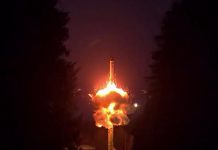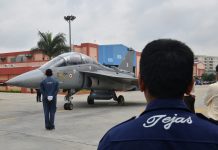In a first, the US-made MQ-9B SeaGuardian drone successfully deployed a sonobuoy, which could revolutionize anti-submarine warfare (ASW), its maker General Atomics claims.
While the experiment was conducted on November 24 last year, the American aerospace firm has released a video on this just a week back.
According to a press release by General Atomics Aeronautical Systems, the company has collaborated with the US Air Force and L3Harris Technologies to expand the mission capabilities of the MQ-9 Reaper.
The versatile Remotely Piloted Aircraft (RPA) is a medium altitude and long endurance aircraft with the capability to deploy and monitor sonobuoys and deliver maritime domain awareness on the surface and below it.
The 26th Weapons Squadron (WPS) of the US Air Force flew an MQ-9 equipped with the Reaper Defense Electronic Support System (RDESS). The flights were conducted in parallel with the Advanced Battle Management System (ABMS) demonstrations recently in Europe.
The recent experiment involving the SeaGuardian drone is seen as a milestone in anti-submarine warfare (ASW).
“RDESS is a passive, broad-spectrum Electronic Support Measure (ESM) payload, which is designed to geo-locate and collect signals of interest from standoff ranges. It gives the Reaper advanced ability to conduct even more flexible surveillance as it has sensors which provide high-quality intelligence but also maintains its security in friendly or international airspace,” the company said in the statement.
The video shows the “demonstration of carriage, release, process and control of an A-size sonobuoy by a company-owned MQ-9 Reaper,” it said
What Are Sonobuoys?
A sonobuoy is an object detection and identification device used in the water. Mostly, it is used to detect submarines by either listening to the sounds produced by propellers and machinery which is known as “passive detection” or by bouncing a sonar ping off the surface of the submarine which is known as active detection.
Sonobuoys are manufactured in several sizes like A, B, C, F, G to name a few. According to Naval News, all US-manufactured sonobuoys except the MK-84, are A-size with dimensions of 4.7/8 inches X 36 inches (approx.). It helps in collecting geo-location of the submarines making it an extremely important weapon in anti-submarine warfare.
The SeaGuardian Drone
The maritime variant of the MQ-9B SeaGuardian drone used to perform over-the-horizon long-endurance, medium-altitude Intelligence, surveillance and reconnaissance (ISR) missions. Due to its multi-skilled Electro-Optical (EO)/ Infra-Red (IR) system, the SeaGuardian is easily able to operate most of the ISR missions of its variant — ‘SkyGuardian’.
The SeaGuardian can easily carry out anti-surface warfare (ASuW), anti-submarine warfare (ASW), search and rescue (SAR), humanitarian assistance and disaster relief (HADR), borders surveillance and law enforcement. It can carry two to four sonobuoy dispensers under its wings for ASW missions and carries a sonobuoy receiver and processor internally.
Due to the focus on joint-defense systems by the countries worldwide, SeaGuardian becomes a convincing aircraft for the military to conduct maritime and littoral operations.
General Atomics Vice President for DoD Strategic Development, J.R. Reid, said, “Our effort in AI (artificial intelligence) and ML (machine learning) is further advancing the MQ-9’s autonomous capabilities which will greatly enhance its mission resiliency during periods of contested electromagnetic spectrum operations.”




